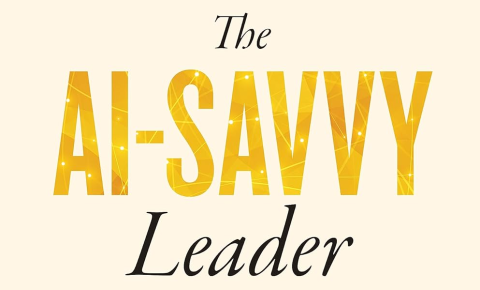The AI-savvy Leader: on how AI should be a human-centred approach
Back in June I joined a Harvard Business Review webinar focusing on the launch of ‘The AI-Savvy Leader: Nine Ways to Take Back Control and Make AI Work’, the latest book by author and Professor, David De Cremer. The main objective of the book is to explore the factors and behaviours that characterise ‘AI-Savvy’ leaders who embrace the deployment of AI as a useful tool to enhance our work as well as to improve an organisation’s ability to create and innovate.
De Cremer is convinced that, at least as things stand, AI will never be able to replace the humans because it lacks the practical exposure to those day-to-day life situations that allow us to adapt our behaviours, actions and decisions to a specific context. For example, AI can write an email for us but doesn’t have enough cultural and contextual knowledge to craft something that reflects our company, communication style, and preferences of the receiving person in the way in which we can. In the same way, it can’t ‘read between the lines’ to fully understand someone else’s message and respond to it appropriately.
However, AI is here to stay and will continue to be leaders’ biggest challenge, mainly because it is proving to be particularly difficult to adopt and adapt to it while still trying to understand it. This is one of the main raisons why, at the moment, a significant number of AI initiatives don’t make it beyond the pilot stage. According to De Cremer, many leaders and organisations often forget that a tech transformation is still a business change that needs to be implemented in a business setting. It shouldn’t therefore be completely delegated to the ‘tech experts’ but should instead be aligned to an organisation’s purpose and objectives. In other words, it also entails a culture change and the contribution of all involved. Too often the focus of AI initiatives is mainly on how AI can generate efficiency and productivity gains through automation. overlooking their potential to enhance human performance.
In his book, De Cremer explains how, in order to navigate AI transformation successfully, organisations and leaders need a shift in mindset towards a higher focus on the workforce and on the human reactions to AI as well as towards a trust-based, motivational and participative leadership that continuously learns from and adapts to the process by leveraging the feedback of those involved. The book offers an approach for leaders and companies to adopt, to avoid the common pitfalls that they may encounter when carrying out AI transformation. Each chapter looks at a different leadership aspect that in De Cremer’s opinion can be crucial in this type of processes. The nine factors explored are: learning, purpose, inclusion, communication, vision, balance, empathy, mission and emotional Intelligence.
Although these are fairly traditional core leadership elements, ‘The AI-Savvy Leader’ describes how leaders can apply them in the context of AI by changing their behaviours and their ways of thinking and communicating. No matter what the AI-related challenges will be in the future, these skills will continue to be extremely important in trying to combine the use of AI with the human contribution to create value for the individuals and organisations alike.
The book provides examples of good practice that could help leaders thrive in the current technology-led business world by strengthening a few of their interpersonal skills, including for example their agility of thought and adaptability to what really matters, their ability to think critically, their curiosity, and their willingness to continue to learn and stay up to date. Of course, without forgetting that, regardless of the nature of a process, humans are ultimately the most important factor and should therefore continue to be seen as the priority when leading a transformation.
De Cremer also recently wrote an article on the importance of engaging with all stakeholders involved in the adoption of AI to improve organisational performance.
Valentina Lorenzon is a member of the CMCE Coordination group and editor of the CMCE newsletter.
